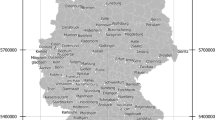Abstract
The visualization of specific attributes of the maps is not achieved with standard maps representations or area cartograms. Adaptive Maps can deal with multiple attributes like travel time, quality of the road or tourism interest of the path between two points.
A method to generate and visualize Adaptive Maps is proposed. It departs from a graph with multiple attributes and generates a single measurement matrix that represent the desired distance between points. A Multidimensional Scaling problem on that matrix is solved to finally visualize the adapted map.
To illustrate the proposal, 4 adapted maps are generated and visualized.
Access this chapter
Tax calculation will be finalised at checkout
Purchases are for personal use only
Similar content being viewed by others
References
Cox, T.F., Cox, M.A.: Multidimensional Scaling. CRC Press, Boca Raton (2000)
Gallo, G., Pallottino, S.: Shortest path algorithms. Ann. Oper. Res. 13(1), 1–79 (1988)
Goldberg, A.V., Harrelson, C.: Computing the shortest path: a search meets graph theory. In: Proceedings of the Sixteenth Annual ACM-SIAM Symposium on Discrete Algorithms. pp. 156–165. Society for Industrial and Applied Mathematics (2005)
Gross, J.L., Yellen, J.: Handbook of Graph Theory. CRC Press, Boca Raton (2004)
White Jr., M.S., Griffin, P.: Piecewise linear rubber-sheet map transformation. Am. Cartographer 12(2), 123–131 (1985)
Sagar, B.D.: Cartograms via mathematical morphology. Inf. Vis. 13(1), 42–58 (2014)
Sun, S.: A fast, free-form rubber-sheet algorithm for contiguous area cartograms. Int. J. Geogr. Inf. Sci. 27(3), 567–593 (2013)
The R Project for Statistical Computing (2017). www.r-project.org
The R Stats Package (2018). www.rdocumentation.org/packages/stats
Tobler, W.R.: A continuous transformation useful for districting. Ann. New York Acad. Sci. 219(1), 215–220 (1973)
Acknowledgments
Authors acknowledge support through projects TIN2014-55024-P and TIN2017-86647-P from the Spanish Ministry of Economy and Competitiveness (including FEDER funds).
M. Torres enjoys a Ph.D. research training staff grant associated with the project TIN2014-55024-P and co-funded by the European Social Fund.
Author information
Authors and Affiliations
Corresponding author
Editor information
Editors and Affiliations
Rights and permissions
Copyright information
© 2018 Springer International Publishing AG, part of Springer Nature
About this paper
Cite this paper
Torres, M., Pelta, D.A., Verdegay, J.L. (2018). A Proposal for Adaptive Maps. In: Medina, J., Ojeda-Aciego, M., Verdegay, J., Perfilieva, I., Bouchon-Meunier, B., Yager, R. (eds) Information Processing and Management of Uncertainty in Knowledge-Based Systems. Applications. IPMU 2018. Communications in Computer and Information Science, vol 855. Springer, Cham. https://doi.org/10.1007/978-3-319-91479-4_54
Download citation
DOI: https://doi.org/10.1007/978-3-319-91479-4_54
Published:
Publisher Name: Springer, Cham
Print ISBN: 978-3-319-91478-7
Online ISBN: 978-3-319-91479-4
eBook Packages: Computer ScienceComputer Science (R0)




